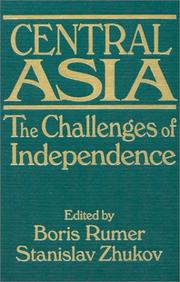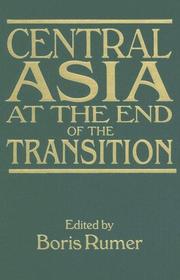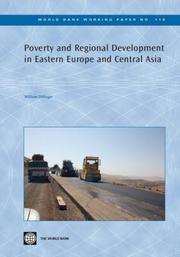| Listing 1 - 6 of 6 |
Sort by
|

ISBN: 0765602547 Year: 1998 Publisher: Armonk, NY : Sharpe,
Abstract | Keywords | Export | Availability | Bookmark
 Loading...
Loading...Choose an application
- Reference Manager
- EndNote
- RefWorks (Direct export to RefWorks)
Book
ISBN: 9782200249069 2200249063 Year: 2010 Publisher: Paris: Armand Colin,
Abstract | Keywords | Export | Availability | Bookmark
 Loading...
Loading...Choose an application
- Reference Manager
- EndNote
- RefWorks (Direct export to RefWorks)
Geopolitics --- Géopolitique --- Asia, Central --- Asie centrale --- Economic conditions --- Foreign relations --- Politics and government --- Conditions économiques --- Relations extérieures --- Politique et gouvernement --- Social conditions --- Foreign economic relations --- Economic policy --- Globalization --- Géopolitique --- Conditions économiques --- Relations extérieures --- Asia, Central - Politics and government - 21st century --- Asia, Central - Social conditions - 21st century --- Asia, Central - Foreign relations --- Asia, Central - Foreign economic relations --- Asia, Central - Economic policy --- Asia, Central - Economic conditions

ISBN: 0765615762 0765615754 9780765615763 Year: 2005 Publisher: Armonk, N.Y. : M.E. Sharpe,
Abstract | Keywords | Export | Availability | Bookmark
 Loading...
Loading...Choose an application
- Reference Manager
- EndNote
- RefWorks (Direct export to RefWorks)
Geopolitics --- Asia, Central --- Politics and government --- Foreign relations --- Economic policy --- Social policy --- -958.043 --- World politics --- Central Asia --- Soviet Central Asia --- Tūrān --- Turkestan --- West Turkestan --- Asia --- -Foreign relations --- -Politics and government --- -Social policy. --- Géopolitique --- Asie centrale --- Social policy. --- Politique et gouvernement --- Relations extérieures --- Politique économique --- Politique sociale --- Geopolitics - Asia, Central --- Asia, Central - Politics and government - 1991 --- -Asia, Central - Foreign relations - 1991 --- -Asia, Central - Economic policy - 1991 --- -Asia, Central - Social policy

ISBN: 0821371614 9780821371619 9780821371626 0821371622 9786610940370 1280940379 Year: 2007 Volume: 118 Publisher: Washington: World bank,
Abstract | Keywords | Export | Availability | Bookmark
 Loading...
Loading...Choose an application
- Reference Manager
- EndNote
- RefWorks (Direct export to RefWorks)
Regional economic development is an interest of policymakers throughout the Europe and Central Asia (ECA) region. One of its principal aims is to reduce poverty in lagging regions by stimulating local economic growth. However, problems exist with this approach. First, it may miss the target. Although geographical concentrations of poverty exist, poor people also live in regions that are-on average-rich. Second, the sources of the problem may be misdiagnosed. Poverty is not only related to where people are, but to who people are. In ECA, poverty is associated with low levels of education and pe
Poverty --- Pauvreté --- Europe, Eastern --- Asia, Central --- Europe de l'Est --- Asie centrale --- Economic policy --- Politique économique --- Poverty. --- Business & Economics --- Economic History --- Destitution --- Wealth --- Basic needs --- Begging --- Poor --- Subsistence economy --- Poverty - Europe, Eastern --- Poverty - Asia, Central --- Pauvreté - Europe de l'Est --- Pauvreté - Asie centrale --- Europe, Eastern - Economic policy - 1989 --- -Asia, Central - Economic policy - 1991 --- -Europe de l'Est - Politique économique - 1989 --- -Asie centrale - Politique économique - 1991 --- -Poverty --- -Poverty - Europe, Eastern
Book
ISBN: 1283224097 9786613224095 9264097287 9264097279 9789264097285 Year: 2011 Publisher: [Paris] : OECD,
Abstract | Keywords | Export | Availability | Bookmark
 Loading...
Loading...Choose an application
- Reference Manager
- EndNote
- RefWorks (Direct export to RefWorks)
With a total population of 92 million people, near universal literacy and abundant energy resources, Central Asia is an attractive destination for investment and trade. The region is strategically located at the crossroads of Europe and Asia, and surrounded by some of the world’s fastest-growing economies such as Russia, India and China, who are increasingly investing in the region. From 2000 to2009, foreign direct investment flows into Central Asia increased almost ninefold, while the region’s gross domestic product grew on average by 8.2% annually. While Central Asia is endowed with many natural and human resources that could drive its economies to even higher levels of competitiveness, the poor quality of the region’s business environment remains a major obstacle. Key areas for improvement include reinforcing legal and economic institutions; prioritizing the development of the small and medium-sized enterprise (SME) sector; and building the capacity of business intermediary organisations. This Central Asia Competitiveness Outlook examines the key policies that would increase competitiveness in Central Asia and reduce dependence on the natural resource sector, namely through developing human capital, improving access to finance, and capturing more and better investment opportunities. It was carried out in collaboration with the World Economic Forum under the aegis of the OECD Central Asia Initiative, a regional programme that contributes to economic growth and competitiveness in Afghanistan, Kazakhstan, the Kyrgyz Republic, Mongolia, Tajikistan, Turkmenistan, and Uzbekistan. The Initiative is part of the wider OECD Eurasia Competitiveness Programme.
Asia, Central -- Economic policy -- 1991-. --- Competition -- Asia, Central. --- Investments, Foreign -- Government policy -- Asia, Central. --- Competition --- Investments, Foreign --- Asia, Central --- Business & Economics --- Economic History --- Economic policy --- Economic conditions --- Economic development --- Development, Economic --- Economic growth --- Growth, Economic --- Competition (Economics) --- Competitiveness (Economics) --- Economic competition --- Economic aspects --- Economics --- Statics and dynamics (Social sciences) --- Development economics --- Resource curse --- Commerce --- Conglomerate corporations --- Covenants not to compete --- Industrial concentration --- Monopolies --- Open price system --- Supply and demand --- Trusts, Industrial --- Social conditions
Book
ISBN: 1283364220 9786613364227 9264112324 9264112316 Year: 2011 Publisher: [Paris] : OECD,
Abstract | Keywords | Export | Availability | Bookmark
 Loading...
Loading...Choose an application
- Reference Manager
- EndNote
- RefWorks (Direct export to RefWorks)
With a total population of over 75 million people and a strategic location between wealthy trading partners, with Russia to the east and a vast market of EU citizens to the west, the Eastern Europe and South Caucasus (EESC) region is attractive as a destination for investment and trade. It is endowed with significant human and resources ranging from the black soil in Ukraine that produces some of the best wheat in the world, to energy reserves in Azerbaijan and unexplored water resources in several countries. However, in spite of recent growth – an average of almost 8% of GDP during 1998-2008 – the region’s productivity levels remain 77% below the world average. The OECD Eastern Europe and South Caucasus Competitiveness Outlook examines the key policies that would increase competitiveness in the countries of the region through developing human capital, improving access to finance for SMEs and creating more and better investment opportunities.
Asia, Central -- Economic policy -- 1991-. --- Competition -- Asia, Central. --- Investments, Foreign -- Asia, Central. --- Investments, Foreign --- Competition --- Finance --- Business & Economics --- Investment & Speculation --- Government policy --- Europe, Eastern --- Caucasus, South --- Economic policy --- Economic policy. --- Competition (Economics) --- Competitiveness (Economics) --- Economic competition --- Capital exports --- Capital imports --- FDI (Foreign direct investment) --- Foreign direct investment --- Foreign investment --- Foreign investments --- International investment --- Offshore investments --- Outward investments --- Economic aspects --- Haravayin Kovkaz --- I︠U︡zhnyĭ Kavkaz --- Samxretʻ Kavkasia --- South Caucasus --- Transcaucasia --- Transcaucasus --- Zakavkazʹe --- Zakavkazʹye --- Commerce --- Conglomerate corporations --- Covenants not to compete --- Industrial concentration --- Monopolies --- Open price system --- Supply and demand --- Trusts, Industrial --- Capital movements --- Investments
| Listing 1 - 6 of 6 |
Sort by
|

 Search
Search Feedback
Feedback About UniCat
About UniCat  Help
Help News
News